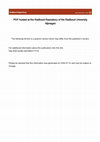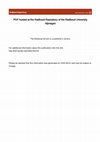Papers by Etiënne Rouwette

Frontiers in Sustainable Food Systems
There is a scarcity of research on building nutrition-sensitive value chains (NSVCs) to improve d... more There is a scarcity of research on building nutrition-sensitive value chains (NSVCs) to improve diets and nutrition outcomes of populations in the Caribbean. This study contributes to filling this research gap by outlining a participatory approach to evaluating a NSVC model for “farm to fork” (F2F) school feeding in the Eastern Caribbean Island of St. Kitts. Using a combined group model building (GMB) and theory of change (ToC) approach, policy actors and other stakeholders (n = 37) across the school feeding value chain were guided through a facilitated process to evaluate the ToC underlying a series of F2F interventions designed to enhance childhood nutrition. Stakeholders at the workshop engaged collaboratively to create a causal map of interconnected “system factors” that help explain behaviors contributing to unhealthy eating among children that extended well-beyond the original F2F project ToC that had been used to inform interventions. Through this facilitated GMB process, sta...
Public Administration Review, 2017
research focuses on individual and collective decision making from a game-theoretic and social-ch... more research focuses on individual and collective decision making from a game-theoretic and social-choice-theoretic perspective.

Systems Research and Behavioral Science, 2017
The central question in the paper by Morecroft (2017) is whether 'structure drives behaviour' als... more The central question in the paper by Morecroft (2017) is whether 'structure drives behaviour' also holds over a long time period, or, in other words, whether feedback structures shaping trends endure over time. Morecroft revisits a model of the oil industry originally developed in the late 1980s and, changing only initial parameter settings, concludes that the model is able to represent recent developments. The Limits to Growth model is another example of a feedback structure that can explain behaviour over decennia. The finding that feedback structure is enduring is good news for system dynamicists and increases our confidence in one of the field's central assumptions. This paper discusses the modelling effort described from two perspectives: the process leading up to the final model structure and the wider implications of models that address long term real life problems, in particular for the field of system dynamics.

Disability and rehabilitation, May 23, 2016
This study aimed to explore if and why the return-to-work (RTW) experiences of various workplace ... more This study aimed to explore if and why the return-to-work (RTW) experiences of various workplace stakeholders in the Netherlands and Denmark differ between physical and mental health conditions, and to understand the consequences of potentially different experiences for the RTW process in both health conditions. We studied 21 cases of long-term sickness absence, and held a total of 61 semi-structured interviews with the various actors involved in these cases. Physical cases were seen as "easy" and mental cases as "difficult" to manage, based on the visibility and predictability of health complaints. On this ground, assessing work ability and following required RTW actions were perceived as more urgent in mental than in physical cases. Despite these perceptions, in practice, the assessment of work ability seemed to impair the RTW process in mental cases (but not in physical ones), and the (non-)uptake of RTW actions appeared to have similar results in both mental ...

Introductie Onze wereld is dynamisch. Organisaties, mensen, steden, regio’s en andere verbanden s... more Introductie Onze wereld is dynamisch. Organisaties, mensen, steden, regio’s en andere verbanden staan steeds weer voor nieuwe vraagstukken. De investeringen zijn groot, maar de praktijk is vaak weerbarstig en ondanks dat er veel potentieel is, leidt dit niet altijd tot het vermogen om vraagstukken aan te kunnen. Het vraagt betrokkenheid en aandacht om potentieel en praktijk met elkaar in verband te brengen en het vermogen te blijven versterken om vraagstukken aan te kunnen. Sinds medio jaren negentig hanteer ik het netwerk als ordeningsprincipe en de netwerkanalyse (Poorthuis, 2006) als methode voor het analyseren van het netwerk van betrokkenheid rond een bepaalde kern. Het is bijzonder om te zien hoe we door het analyseren van een netwerk de betrokkenheid fysiek gestalte kunnen geven. In dit hoofdstuk zoek ik naar een patroon waarmee we naast het analyseren van betrokkenheid ook de meervoudige aandacht voor betrekkingen en het besturen van netwerkrelaties kunnen ondersteunen. Mijn ambitie is een verbindend patroon, waarop ik intuïtief kan vertrouwen, dat mijn manier van onderzoekend bouwen ondersteunt, waar ik mee kan spelen, wat ik achter kan laten voor organisaties die daar zelf mee willen werken en wat naast organisaties ook toepasbaar is op andere verbanden zoals sectoren, steden, regio’s en zelfs personen. Ik begin met een verhaal van mijn eigen onderneming en de keuze voor netwerkbenadering. Daarna beschrijf ik het netwerk als ordeningsprincipe en de netwerkanalyse als methode. Ik vervolg met enkele voorbeelden waarbij het netwerk als ordeningsprincipe is gehanteerd. Gevoed door de voorbeelden en gestimuleerd door het zoeken naar verbindingen, kom ik tot een patroon voor het onderzoekend bouwen aan verbanden.
Je weg vinden in het bomenbos: een essay over onderzoek In dit essay geven we een aantal gedachte... more Je weg vinden in het bomenbos: een essay over onderzoek In dit essay geven we een aantal gedachten weer over het doen van onderzoek in, vanuit of gerelateerd aan de professionele praktijk. We gaan in op het gang-bare, op het marginale, op verbinding en op lol. We geven enkele ordeningen weer waarmee je enigszins kunt taxeren in welk gezelschap je verkeert of wilt verkeren als je met onderzoek aan de gang gaat. Het zijn tips, kleine richting-aanwijzers.
Systems Research and Behavioral Science, 2012
Contains fulltext : 111579.pdf (publisher's version ) (Closed access)4 p
Journal of International Business Studies - J INT BUS STUD, 2009
Simulation & Gaming, 1998
The MARCO POLIS management game was developed to introduce employees of housing associations to n... more The MARCO POLIS management game was developed to introduce employees of housing associations to new market conditions. After the game was developed in 1991, it has been used more than 15 times. On most occasions, the game was judged to be highly successful in making the demands of the new situations clear This article examines in depth the results of a game run with 49 participants.
With the advent of Enterprise Resource Planning (ERP) systems, availability of data is no longer ... more With the advent of Enterprise Resource Planning (ERP) systems, availability of data is no longer the bottleneck to decision making in many organizations. Instead the reverse seems to apply more frequently. Integrated organization-wide computer systems overwhelm managers with data to such an extent that it becomes difficult to assess relevance for managing operations. A number of methodologies attempt to help m anagem ent to distill meaning from large amounts of data. These methodologies enable managers to identify multiple performance indicators and determine tradeoffs between effects of proposed improvements.

Concentrates on procedures used to foster group learning for a particular type of problem, the so... more Concentrates on procedures used to foster group learning for a particular type of problem, the so-called messy problem. The distinctive feature of messy problems is that the people involved have different ideas on what the problem is or whether there even is a problem. Nevertheless, those involved in the problem depend on one another as some form of cooperation is needed to improve the situation. In other words, a process of group learning is required. In the last few decades, different procedures have been developed to support group learning of managers and experts involved in a messy problem. This chapter describes the shared features of these methods and tries to group effective elements by relating them to the phases in a generic information-processing model. For each phase, we survey recent research with an emphasis on expert and naturalistic decision making. We then consider how group-decision support procedures try to influence group activities in each phase. We conclude this...
This chapter focuses on the use of groupware to support local governments in activities in the in... more This chapter focuses on the use of groupware to support local governments in activities in the intelligence cycle. Local governments in The Netherlands have a central role in developing integral safety plans for their district. However, in the implementation of safety plans the contribution of partner organizations such as the fire department and police force is indispensable. Each of the partners may have its own priorities with









Uploads
Papers by Etiënne Rouwette